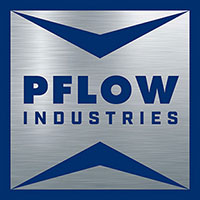

Milwaukee, Wisconsin, 53209
United States
414-352-9000
www.pflow.com PFlow Industries Company Profile


What keeps orders on track and customers happy in today’s ultra-integrated supply verticals? PFlow Industries dive into how vertical reciprocating conveyors help optimize the automated material handling systems and pick-and-pack processes that drive today’s “just-in-time” economy.
Whether you’re supporting last-mile deliveries to consumers or keeping manufacturers supplied with just the right parts at just the right time, your business depends on your ability to manage your inventory and to quickly pick, pack, and ship materials as they are needed.
Automated material handling systems provide part of the solution, but fold any material-handling workflow into a typical multi-floor storage facility, and you’ll quickly see the need for a rock-solid way to move large amounts of inventory between vertical levels quickly, efficiently, and safely.
Vertical reciprocating conveyors (VRCs) provide just that: safe, robust lifting capacity that fits any space and can be integrated with almost any other automated system. Also known as material lifts, VRCs feature a customizable footprint, flexible design, and tried-and-true reliability that makes these lifting warehouse workhorses the missing link you need to take your automated material handling systems to the next level.
Let’s take a closer look at some of the key benefits VRCs bring to your warehouse automation and pick-and-pack processes:
Now let’s consider four ways in which VRCs can help you achieve more by optimizing critical parts of your warehouse processes.
Multi-level warehouses can make the tracking of deliveries and stock movement difficult. Automating materials movement between floors using VRCs integrated with your RFID (radio frequency identification) or barcode tracking systems allows precise control of stock levels. That means fewer errors, smaller discrepancies, and less downtime for stock reconciliation.
VRCs are built for safe, efficient movement of materials between floors. Forget limitations – VRCs can handle virtually any size or weight material load and can reach any number of floor levels, and they eliminate manual lifting and operational bottlenecks, allowing you to move bulk goods or individual items with ease.
The direct-to-consumer model thrives on flawless, high-speed fulfillment, particularly for complex orders. VRCs become your secret weapon for efficiency throughout the entire pick-and-pack process.
Seamless Multi-Level Integration: Forget clunky material handling. VRCs integrate seamlessly with conveyor systems, robots, and pick modules. This allows effortless transfer of goods between levels, regardless of complexity, and streamlines movement from picking to packing.
Strategic SLAM Support: The final 100 feet of your warehouse, the SLAM area (scan, label, apply, manifest), is crucial for fast and accurate order processing. VRCs play a key role by efficiently transferring products directly to the SLAM area or providing quick access to critical supplies stored above these stations. This translates to faster order fulfillment and happier customers.
Ditch disjointed workflows! Instead of relying on forklifts, scissor lifts, side loaders, or manual labor to move materials between floor levels, VRCs complete multi-level facility automation. VRCs can be incorporated into automated conveyor systems as simple, two-level lifting equipment or as complex multi-level, multi-directional systems that enable flexible loading and unloading patterns to and from horizontal conveyors or autonomous vehicles.

VRCs can solve even your most complicated lifting challenges at every stage of your material handling operation and optimize your warehouse processes by:
VRCs can be customized for each vertical material lifting need within your facility. From your receiving dock, to pick module replenishment, to your SLAM area, these versatile material lifts can help optimize movement of multiple pallet loads to individual items to multiple floor levels.
Maximize your warehouse footprint with a VRC designed specifically for your facility. Engineered to serve any number of floor levels, with versatile load and unload patterns, VRCs can be installed through floors, in elevator shafts, on the outside of your building, next to mezzanines – virtually anywhere you need!
VRCs can be fully integrated with other conveyors and autonomous vehicles to enable multi-level automated workflows, allowing for optimized facility throughput.
The last 100 feet of your warehouse or SLAM (scan, label, apply, and manifest) area is critical to connecting the complex algorithms of online ordering platforms and integrated supply chain management to the actual items going out the door.
Many warehouse operators have boosted SLAM area efficiency by strategically placing VRCs in areas that help to transport goods directly to their final packing stations and can also help provide quick and easy access to supplies that are often stored on mezzanine levels above the SLAM area.
PFlow Industries created the original vertical reciprocating conveyor concept to provide a simple, safe, and reliable way to lift loads in warehouses and factories without relying on forklifts, elevators, cumbersome scissor-lifts, or space-eating inclined conveyors. Since then, our units have redefined efficient, reliable industrial lifting in thousands of facilities around the world.
Now, our VRCs are also a key part of driving warehouse and distribution center operational efficiency.
Contact us about your specific workflow and material-handling goals. We’ll design a custom-built solution that meets your automation needs from simple two-level material lifting to full-scale integration with facility-wide warehouse automation systems.
Our smart, robust VRCs deliver next-generation performance today and bottom-line value long into the future. We back up every unit we build with industry-leading support, including:



